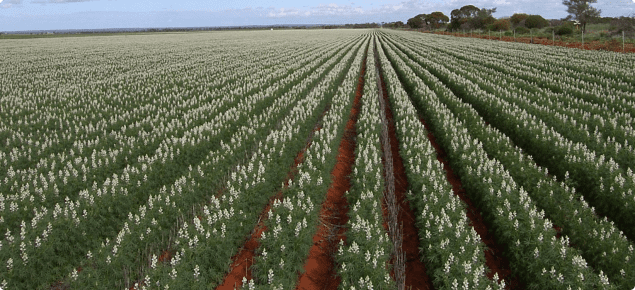SOME growers in Western Australia’s northern grain belt have been growing lupins on wider rows in an attempt to improve the drought tolerance of the crop.
Grains Research and Development Corporation (GRDC) grower relations manager – west, Jo Wheeler, says lupins have traditionally been grown on narrow row spacings of 15 to 18 centimetres in WA but some growers in recent years have been growing them on wider rows at 50cm.
Ms Wheeler said lupins were well suited to the sandplain soils of the northern grainbelt and provided a valuable nitrogen source and disease break for subsequent crops.
“However, discovering systems to improve the yield of lupins is important in WA, as the area sown to this crop has declined rapidly since the late 1990s,” she said.
“Part of the reason for the decline is canola varieties are now available that are well adapted to northern lupin production areas.”
Ms Wheeler said lupins planted on wider rows grew more slowly than narrow row lupins.
“It is believed they intercept less sunlight and use less water given there are effectively double the plants per metre within each row, leaving more soil moisture in the inter-row for the crop to access later in the season for grain fill,” she said.
“Research has demonstrated that in warm environments, there has been little if any yield penalty in growing lupins on wide rows compared with more traditional row spacings.
“Wide row lupins also commonly grow about five centimetres taller than narrow row lupins, which can make harvest easier.
“However, in general terms, the agronomy of growing wide row and narrow row lupins is similar, including for variety selection, fertiliser rates and a seeding rate to achieve an overall plant density of 40 to 45 plants per square metre.”
Ms Wheeler said members of the Geraldton port zone GRDC Regional Cropping Solutions Network (RCSN) had identified that a number of growers in the region were struggling to grow profitable lupins.
But they also recognised there were some growers in the port zone who had created a successful system for growing this valuable commodity.
That first-hand knowledge about growing lupins profitably has led to the Grains Research and Development Corporation (GRDC) publishing ‘Growing lupins with wide row spacing in the northern agricultural zone’, that includes 10 grower case studies and recent research findings.
Ms Wheeler said a number of the growers featured in the booklet – both those with and without wide row lupin systems – were now reverting to top-dressing their fertiliser rather than placing it with the seed.
“Local trials by CSBP have shown that a number of fertilisers, even so-called ‘safe’ products, caused fertiliser toxicity and reduced crop establishment when they were placed by the seed,” she said.
“Another key message from many of the growers profiled was that they aimed to sow lupins dry into warm soils in paddocks with a low weed burden, to maximise the potential for the crop to establish well before the weather turned cold.”
Source: GRDC
‘Growing lupins with wide row spacing in the northern agricultural zone’ was compiled by CussonsMedia and is available at http://bit.ly/2EXduIJ.



HAVE YOUR SAY